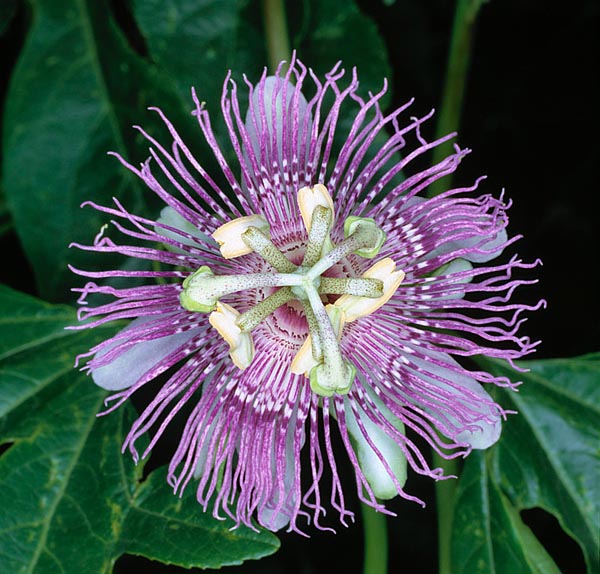Family : Passifloraceae

Text © Pietro Puccio

English translation by Mario Beltramini

Passiflora incarnata is a perennial climber with 7 cm flowers. Medicinal virtues © Giuseppe Mazza
The name of the genus is the combination of the Latin terms “passio, -onis” = passion and “flos, -oris” = flower, with reference to the structure of the flower where the first Spanish missionaries did glimpse the instruments of the Passion of the Christ; the name of the species is the Latin adjective “incarnatus, a, um” = having the colour of the skin, with reference to the colour of the flowers.
Common names: apricot-vine, large passion-flower, may apple, maypop, maypops, maypop passionflower, wild apricot, wild passionflower, wild passion vine (English); passiflore pourpurine (French); Passionsblume, Winter- harte Passionsblume (German).
The Passiflora incarnata L. (1753) is a perennial climbing species, herbaceous, which anchors on the supports by means of tendrils produced at the axil of the leaves, with cylindrical stems, usually long up to 2-3 m, glabrous or finely hairy.
The leaves, on an up to 8 cm long petiole provided with 2 nectar glands at the apex, are alternate, 6-15 cm long and broad, tri-lobed, with ovate-lanceolate to oblong-lanceolate lobes with three nervations and slightly serrate margins, dark green on the upper page, glaucous green below; the stipules (outgrowths at the base of the petiole serving to protect the leaf during the first stages of its development) are pointed (subulate) 2-3 mm long, deciduous. Solitary hermaphrodite flowers, axillary, on a 5-10 cm long peduncle, of about 7 cm of diameter, with 5 sepals and 5 petals, all oblong, of 2-3 cm of length and 0,8-1 cm of breadth with blunt apex, of white or lavender colour, and crown of 1,5-2 cm long filaments, of white or lavender colour with pink of purple bands, curled at the apex; the flowers are self-sterile, for the crossed fecundation it is therefore necessary the presence of another plant not obtained by vegetative way from the same one. Rare forms with all the parts of the flower white coloured do exist.
The fruits are ovoid or ellipsoid berries, up to about 5 cm long, of green or yellowish colour when ripe, containing several obovate seeds, about 0,6 cm long, of dark brown colour immersed in a jelly-like pulp (aril), greyish, edible. It reproduces by seed, possibly scarified and kept in water for two days in order to favour its germination, in sandy loam rich of organic substance, kept humid at the temperature of 22-24 °C, with variable and usually long germination times, from some weeks to some months, and early flowering, even at the first year from the sowing; easy is the reproduction by cutting and through root suckers, produced even at a great distance from the mother plant, so much to become, in some situations, invasive.
Floriferous and fast-growing species, it requires full sun for a best flowering, but it stands also a slight shade, it shows a remarkable resistance to the low temperatures, up to about -15 °C, loosing the whole aerial part, but revegetating from the fleshy roots in spring. It grows well in poor, sandy and stony soils, provided well draining, preferably acidic or neutral, and can stand, well rooted, drought periods. It adapts well to the cultivation in pot in sandy loam with addition of organic substance, with regular waterings during the vegetative period and keeping the roots slightly humid in winter. The fruits, ripe when falling from the plant, have a slightly acidulous taste and are consumed, freed by the seeds, fresh or are used for preparing juices, jams and ice-creams.
All parts of the plant are utilized in the traditional medicine in particular in the treatment of anxiety and of insomnia.
Synonyms: Granadilla incarnata (L.) Medik. (1787); Passiflora incarnata var. integriloba DC. (1828); Passiflora kerii Spreng. (1826); Passiflora edulis var. kerii (Spreng.) Mast. (1871).
→ To appreciate the biodiversity within PASSIFLORACEAE family please click here.
